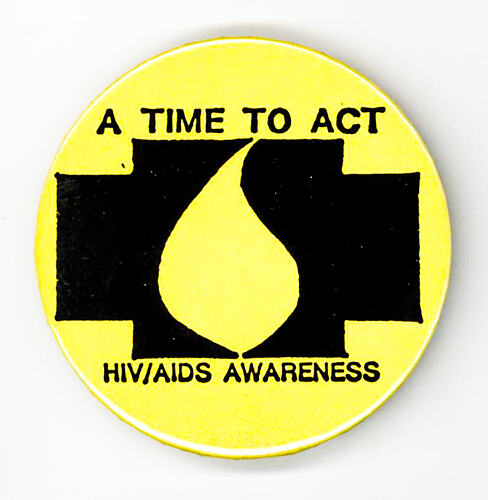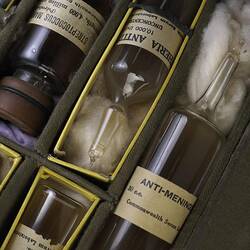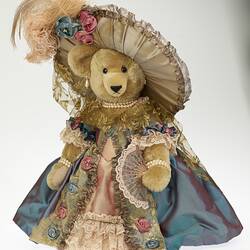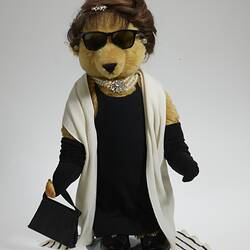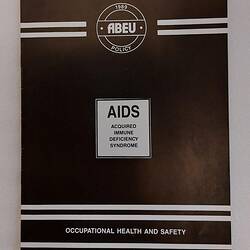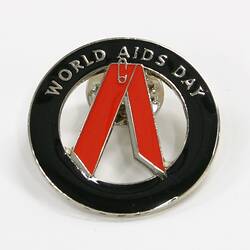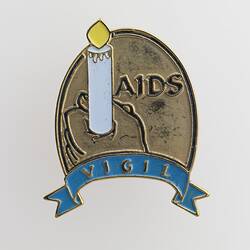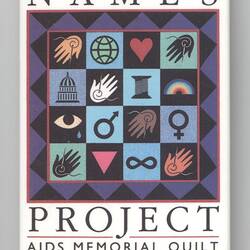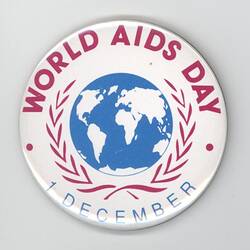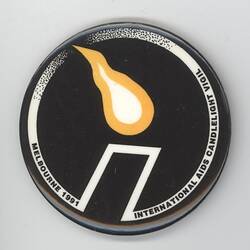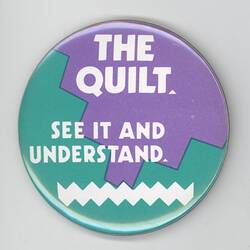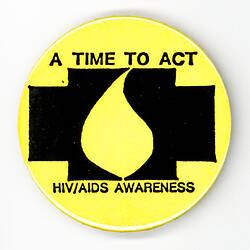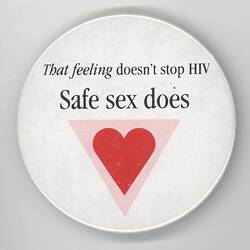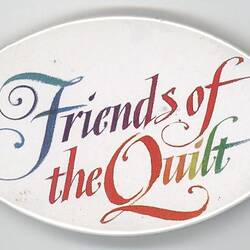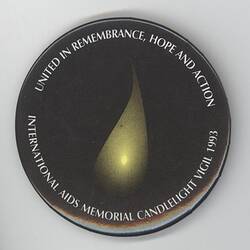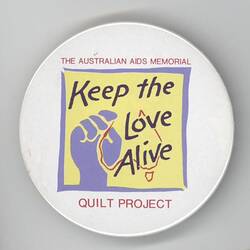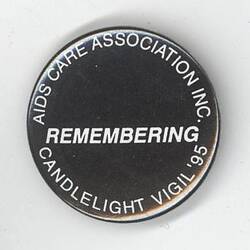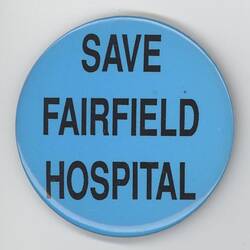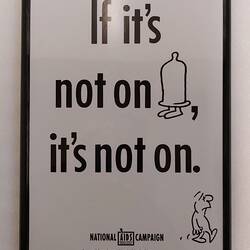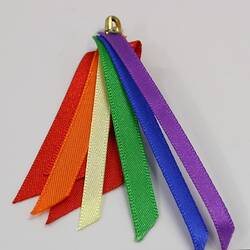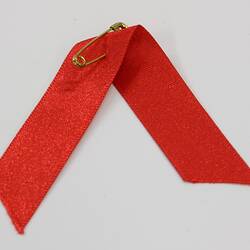Museums Victoria's collection documenting the experience and management of the Human Immunodeficiency Virus (HIV) and the Acquired Immune Deficiency Syndrome (AIDS) epidemic includes health and awareness campaigns, World AIDS Day, the AIDS Memorial Quilt Project, candlelight vigils, organisational policies and medical information.
Between 1983 and 1985, HIV spread rapidly in some Australian communities. While the virus could affect anyone, outbreaks were initially largely gay men in inner urban Melbourne and Sydney, then broadening to include sex workers, IV drug users and blood transfusion recipients.
As HIV and AIDS were increasingly diagnosed in Victorian communities, the Fairfield Hospital for infectious diseases became a centre for AIDS treatment in Victoria. Fairfield Hospital had opened in 1904 (then called the Queen's Memorial Infectious Diseases Hospital) as the first purpose-built isolation hospital for infectious diseases in Victoria. Expertise in research and public health gained it international recognition. Dedication and perfecting of skills led to what became widely known as the 'Fairfield culture of care' which involved medical, nursing, allied health and pastoral care. It also established the Macfarlane Burnett Institute. The combination of its multidisciplinary approach along with active research led to international renown. A passionate campaign was fought against its planned closure in the 1990s, but it closed in June 1996. One section of the site was gazetted as a Public Park and Memorial Garden (containing an AIDS Garden).
Victoria was at the forefront in the development of HIV / AIDS organisations and activism in Australia. The Victorian AIDS Council was formed in 1983. The first Candlelight Vigil was held in Melbourne in 1985, and in 1986 the Gay Men's Health Centre was formed to support the wider health needs of the gay community.
According to the National Association of People Living with AIDS, the International Aids Candlelight Vigil began as an impromptu march by gay men in San Francisco on 2 May 1983, along the route gay rights activists had used to protest the 1978 murder of Harvey Milk, the first openly gay man to be elected to public office in California. The men carried candles in memory of those who had died. They were joined by hundreds along the way in a show of support. The march protested inaction by the government, indifference of the media and public homophobia. Before the end of that year, memorial marches and ceremonies had begun to spread around the world. In Australia, the date for Candlelight Vigils was changed from the international day in May to 1 December - World AIDS day - principally due to weather, according to Colin Krycer (for many years organizer of the Candlelight Vigil and AIDS Quilt ceremonies in Melbourne). Candlelight Vigil items held in Museums Victoria's collection include HT 23145, Badge - 'International Aids Candlelight Vigil', Melbourne, 1991 and HT 23135, Badge - 'International Aids Memorial Candlelight Vigil', 1993.
The Red Ribbon concept, created in New York artists involved in the Visual AIDS organisation in the early 1990s, was brought to Australia by Melburnian Brent Lacey. The simplified Victorian design meant that it could be produced easily and cheaply, and in 1992 the Red Ribbon was worn at the AFL Grand Final, as well as retail outlets of The Body Shop and, in a larger format, tied to Melbourne lamp posts. The World Aids Day organisation now describes the red ribbon as 'an international symbol of AIDS awareness. It is worn by people all year round, and particularly around World AIDS Day, to demonstrate their support for people living with or affected by HIV/AIDS. It is also a symbol of commitment to challenge the stigma and prejudice surrounding HIV/AIDS.'
Wider developments in HIV / AIDS organisations and activism also found voice in Victoria. World Aids Day was founded in 1988 by the World Health Organization (WHO) to raise public awareness about HIV/AIDS issues, including the need for support and understanding for people living with HIV/AIDS and for continued education and prevention initiatives. Badges HT 23131, 'World AIDS Day 1 December and HT 23149, 'World AIDS Day December 1st' were worn by a Melbourne person in the 1990s-2000s.
The Australian AIDS Memorial Quilt Project was founded in Sydney in 1988 by Andrew Carter and Richard Johnson, and formally launched on World AIDS Day, 1 December. The founding 35 quilt panels were displayed with visiting panels from the American Names Project, of which it is part. The Quilt Project is a national registered charity with branches in most states and territories (Australian AIDS Quilt project). Badges from the 1990s - HT 23146, 'Keep the Love Alive' Quilt Project, HT 23136, 'The Quilt' and HT 23148, 'Friends of the Quilt' - collected by a Melbourne donor recall the local significance of the quilt project. Other collection items include MM 145600, Videotape - Eastman Kodak Company, 'Kodak Family Memories/AIDS Quilt', Kodak Park, 6 Apr 1999. On 15 June 2022 it was announced that the Melbourne AIDS Memorial Quilt had formally achieved heritage recognition and protection through inclusion on the Victorian Heritage Register (VHR).
The Names Project was conceived in San Francisco in 1985, when cardboard placards were displayed in a candlelight march in the form of a patchwork in memory of people who had died of AIDS. US AIDS activist Cleve Jones wanted to use the patchwork concept to make a more enduring memorial. Subsequently, the Quilt project was launched in 1987, and by 2009 had grown to over 25,000 panels. The project Quilt has spread to more than 27 countries around the world.
In Australia and beyond, the Names Project has become a valuable resource for the promotion of a compassionate and educational dialogue about AIDS. It graphically illustrates the human side of the AIDS epidemic. The badge HT 23151 'Names Project', AIDS Memorial Quilt, 1993 commemorates the 15th anniversary of a march on Washington in 1987.
References
Kate Davison, 2006. 'Lesbian, Bisexual, Gay, Transgender Material Survey: Project Report 2006', Museums Victoria.
National Association of People Living with AIDS web site http://napwha.org.au accessed 20/11/2022.
William Keys Anderson, 2002. Fever hospital : a history of Fairfield Infectious Diseases Hospital.
Australian AIDS Quilt website The AIDS quilt - The Australian Museum accessed 21/11/2022.
Heritage Council citation no. H1878, former Fairfield Hospital.
'Australia's First AIDS Death', ABC, https://www.abc.net.au/archives/80days/stories/2012/01/19/3411655.htm, accessed 20/11/2022.
'The Red Ribbon', A History of LGBTIQ+ Victoria in 100 Places and Objects. Graham Willett, Angela Bailey, Timothy ,W. Jones and Sarah Rood, 2021, p.68. https://queerarchives.org.au/app/uploads/2021/03/A-History-Of-LGBTIQ-Victorians-in-100-Places-and-Objects.pdf, , accessed 20/6/22. See also Fiona Poulton, Lucy Bracey and Katherine Sheedy, Under the Red Ribbon: Thirty Years of the Victorian AIDS Council / Gay Men's Health Centre, Victorian AIDS Council / Gay Men's Health Centre, South Yarra, 2013.
'We're here. We're Queer. Get used to it!', Old Treasury Building, https://www.oldtreasurybuilding.org.au/protest/queer-rights/, accessed 9/6/22.
Victorian AIDS Council Inc. Annual Report, 1999-2000, https://cdn.thorneharbour.org/media/documents/dda66a52-vacar9900.pdf, accessed 9/6/22.
More Information
-
Keywords
-
Authors
-
Article types
